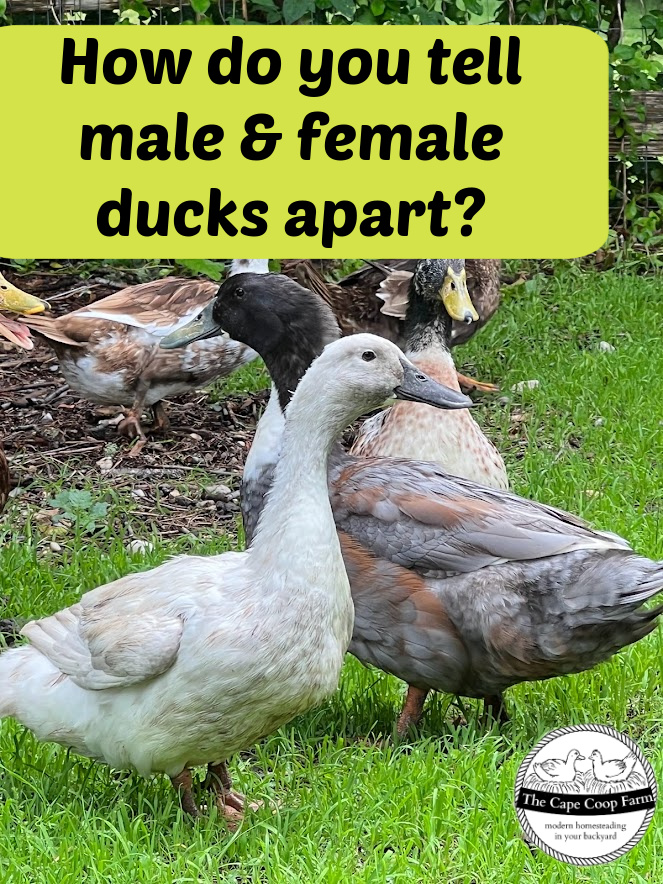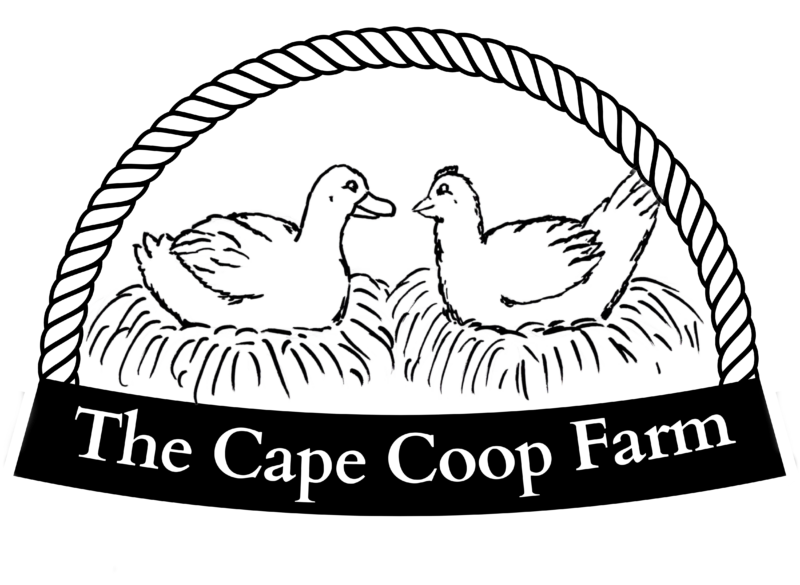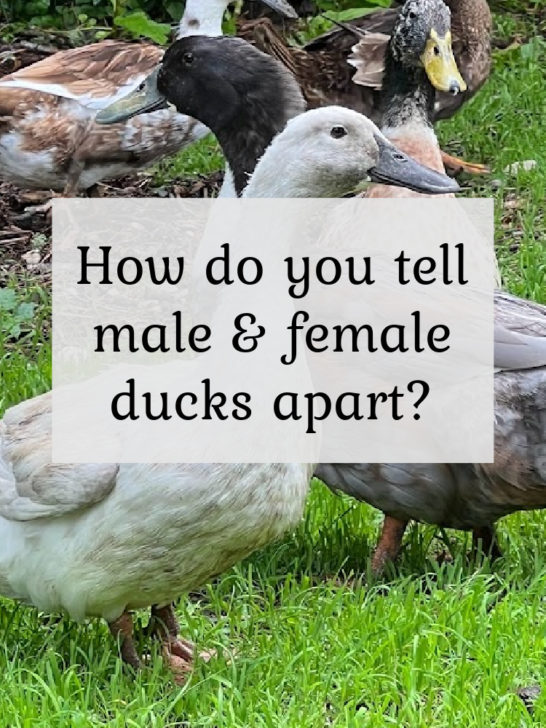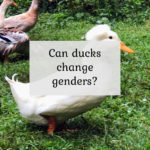---------------------------------------------------------
One of the questions I get asked most often is how to tell the difference between male & female ducks. It can be tricky with some breeds unless you know what to look for. These methods can be used for most domestic duck breeds. I don’t have a ton of knowledge on wild breeds, but many of these methods work for wild ducks too. The majority of domestic duck breeds descend from the mallard, so would work best for distinguishing wild mallards. Let’s discuss some of the most common ways to tell male & female ducks apart.
Voice Sexing Ducks
Voice sexing is one of the easiest & most reliable ways to determine duck gender. You don’t even need to get particularly close to the duck and it works no matter the breed. Male and female ducks have distinctly different “voices” but admittedly this can be difficult for beginners to distinguish. It gets a lot easier if you have both males and females to compare.
Ducklings of both genders will make a “peeping” noise similar to chicks. Somewhere around 6-8 weeks your young ducklings will be maturing into young gentleman and lady ducks. And just like teenage humans, their voices will begin to change. Also not unlike humans, the transition can be a little bumpy! During this time you are likely to hear strangled-sounding peeping or odd high-pitched adult noises. But by the end of their second month, most ducklings will have settled into a more adult “voice”.
Adult female ducks make a louder honking-type noise. Females tend to talk less than males, but their voices are MUCH louder. Males have a low, raspy voice. Where the females tend to have individual “Honk, Honk, Honk” noises, the males have more of a low chattering “WaWaWaWaWa”. The males sort of remind me of a frog! Males are often directing the flock where to go, or calling to the females, so usually talk more.
I’ve put together a YouTube video below that starts with the peeps of 2-week old ducklings, then features “teenage” ducks, adult females, adult males, and then a mixed clip to see if you can pick out the female vs male sounds. You will notice in the background you can often hear the low male voices chattering (mostly because the boys are upset I am chasing the flock trying to get them to talk!).
Bill and Feather Colors
This works better in some breeds than in others. For example, both male & female Pekins are all white (as are many other white production breed ducks). Cayugas and Black & Blue Swedish ducks also have the same feather patterns in both male and female birds. For these breeds, the visual differences come down to size, the males are larger than females.
Many domestic breeds have male feather patterns reminiscent of wild Mallards where the male has a green or dark head with a ring around his neck. The females of these breeds are often much more muted in color – again similar to female Mallards. A few examples of this coloring are Roeuns, Welsh Harlequins, Silver Appleyards, & Saxony.
If you know the breed of duck you have, Google can be your friend in determining color patterns. Do an image search for male and female versions of your duck’s breed.
When to not trust feather color
Let’s make this a little harder. In addition to knowing the breed, you will also want to pay attention to the time of year and age of the duck. Ducklings will have fluffy down feathers until about 6-8 weeks of age which is not their adult coloring. “Teenage” coloring comes in from 8-16 weeks and isn’t always their final coloring. Their teenage color is usually pretty close to a female’s color of their breed. This drabber color helps them hide from predators. When they are approaching maturity, around 16-18 weeks the males will molt their drabber coloring and grow their “nuptial plumage”. This signals to the females they are ready for mating.
What is nuptial plumage? This is the showiest and most colorful feather pattern for each breed. From late fall through winter, the males will grow their nuptial plumage to attract the most mates for the upcoming season. By the middle of summer when mating season is coming to a close, the males will molt most of their colorful feathers in favor of a more predator-safe color scheme. So if you are trying to determine the gender of a duck and it’s late August, feather colors might not be the most reliable gauge. This drab coloring is known as their “eclipse plumage”. You can read more about duck molting here.
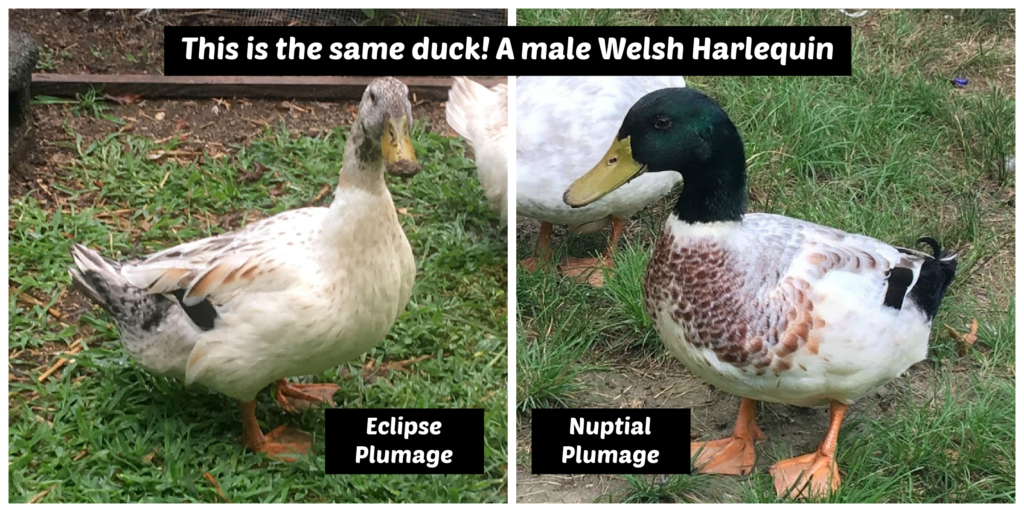
Bill color
Bill color can be hit or miss when determining gender. In some breeds, both male and females will have similar bill colors. But in some breeds, bill color can be used to tell gender. In the breeds very closely related to Mallards males usually have brighter orange/yellow bills and females darker bills. If your duck’s breed features darker head colors & neck rings in males and drabber coloring in females it is a closer Mallard relative. In Pekin ducks, bill color is reversed with females having bright orange bills and males having duller orange bills. To sex your duck by bill color you need to know your duck’s breed and the normal coloring for male vs female bills for that breed.
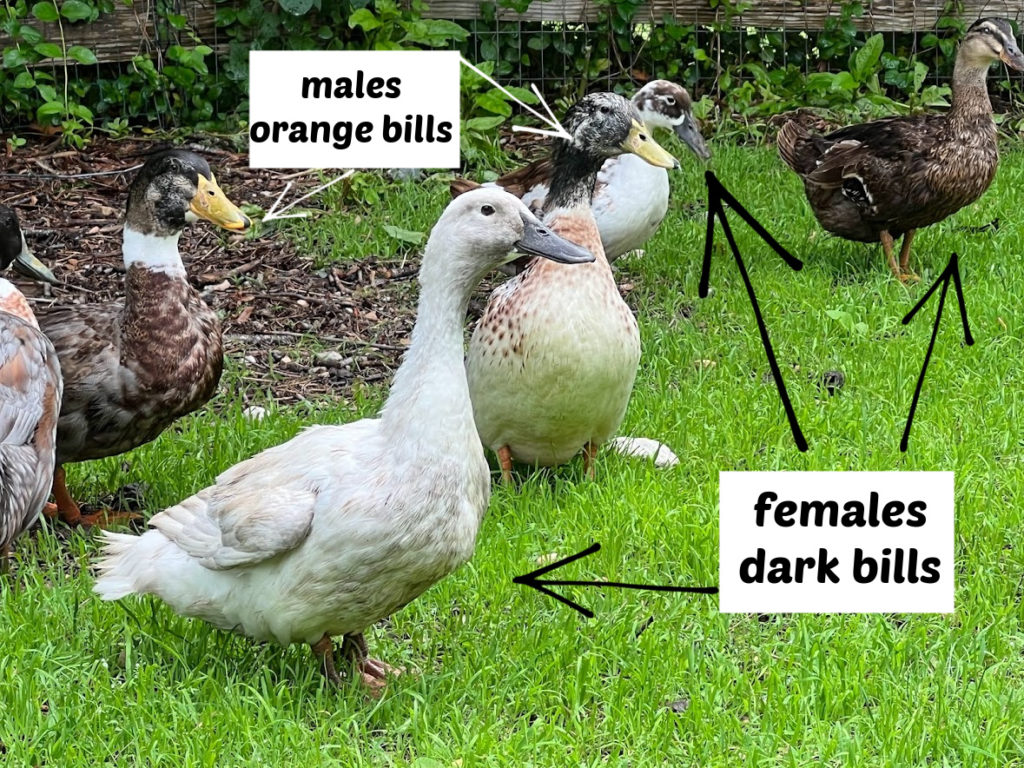

but this female Buff duck would have a darker bill color than a male Buff duck
Another semi-reliable gender indicator on the bill is freckling. If a duck has lots of freckles on her bill, it is a female. If there are no freckles it could be either a male or a female.
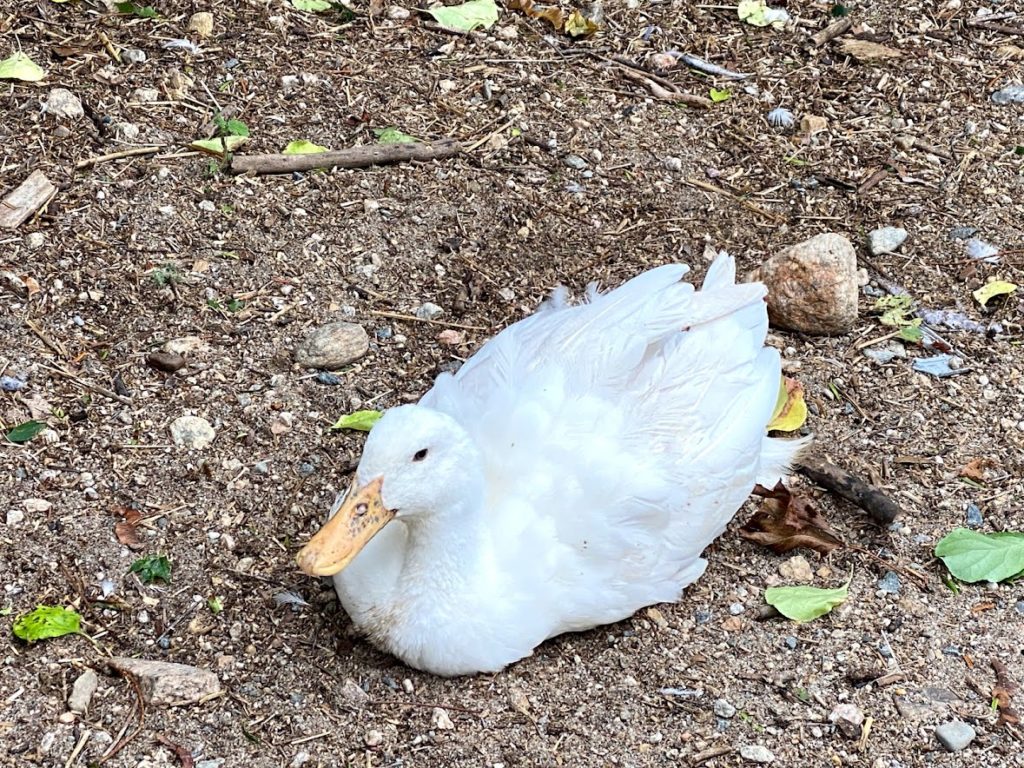
Drake Curl
Slightly more reliable than bill color is the presence of a drake curl. In most adult male domestic ducks, they will have one or more curly feathers at the base of their tail. Females will have smooth feathers. Muscovy male ducks do not have drake curls (because they are not Mallard descendants), but nearly all other domestic breeds will.
This is not 100% foolproof, however. I have had a female duck grow a drake curl (you can read more about her here). Females with drake curls often are the top hen and begin demonstrating male characteristics. It can also be a sign there is a problem with their reproductive system causing them to release too much testosterone. Keep in mind that when the males are in their eclipse plumage they often will molt off their drake curl for a few weeks.
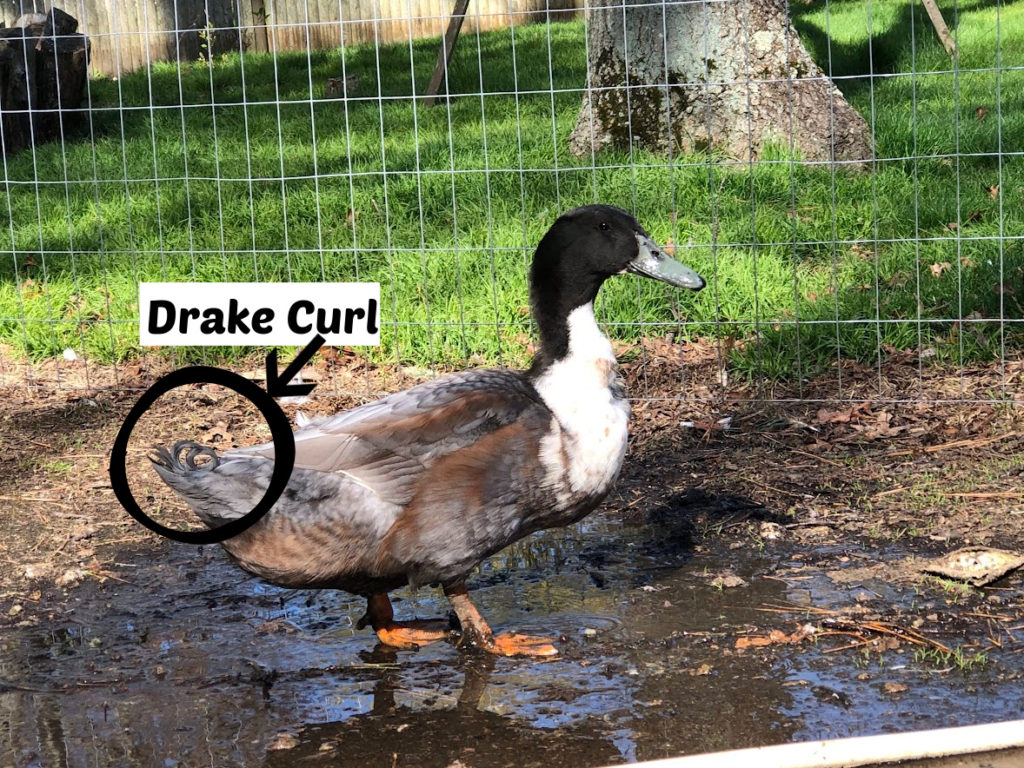
Behavior
Behavior is another hit-or-miss way to determine gender. Too much of a duck’s behavior is based on their personality and not their gender. I have had timid, shy, quiet drakes and also assertive and boisterous hens.
Many people think mating behavior is a good indicator of gender – whoever is on top must be the male right? Not always. Females (especially when there are no males in the flock) will assume a mating position with other females. This is not about mating at all, it’s about dominance and determining who is the leader. It is very common female duck behavior. Male-on-male dominance usually involves more neck wrestling and pinning the other to the ground, but can also look like mating.
I’ve seen males sitting on nests, especially if their favorite female is sitting there. And a female defending a nest or ducklings is much more aggressive than a male any day!
The only behavior that 100% points to male vs female is laying an egg. If you see your duck laying an egg no doubt about it, that’s a female!
Vent Sexing
If you absolutely, positively must know the gender of your duck, vent sexing is the only 100% positive way to determine gender. I don’t usually recommend the average duck keeper tries this as it involves manipulating and observing inside the cloaca (vent). If done improperly it can injure the duck. Ducks do not have external genitals, everything is located internally. By opening the vent you can expose the cloacal walls. By exerting pressure, if your duck is a male, a corkscrew-shaped penis will protrude from the vent. If it is a female, it will simply look like a series of folds. Again, I do not recommend doing this unless you absolutely have to know so that you don’t accidentally hurt your duck.
Did you end up with some drakes and you are wondering what that might mean for your flock? Click here to read more about raising drakes in your duck flock.
